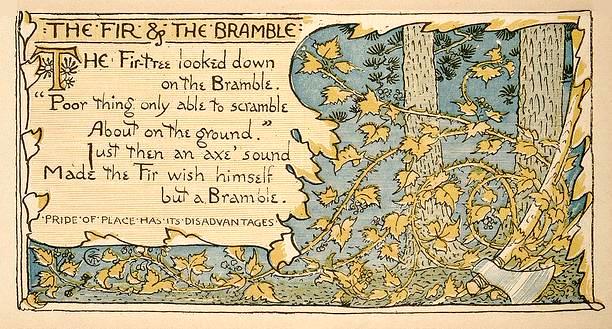The Fir and the Bramble on:
[Wikipedia]
[Google]
[Amazon]
 The Fir and the Bramble is one of
The Fir and the Bramble is one of
Illustrations from books
{{Aesop Fir and the Bramble Fir and the Bramble Fir and the Bramble
 The Fir and the Bramble is one of
The Fir and the Bramble is one of Aesop's Fables
Aesop's Fables, or the Aesopica, is a collection of fables credited to Aesop, a slave and storyteller believed to have lived in ancient Greece between 620 and 564 BCE. Of diverse origins, the stories associated with his name have descended to ...
and is numbered 304 in the Perry Index
The Perry Index is a widely used index of "Aesop's Fables" or "Aesopica", the fables credited to Aesop, the storyteller who lived in ancient Greece between 620 and 560 BC. The index was created by Ben Edwin Perry, a professor of classics at the Un ...
. It is one of a group in which trees and plants debate together, which also includes The Trees and the Bramble
The Trees and the Bramble is a composite title which covers a number of fables of similar tendency, ultimately deriving from a Western Asian literary tradition of debate poems between two contenders. Other related plant fables include The Oak and ...
and The Oak and the Reed
The Oak and the Reed is one of Aesop's Fables and is numbered 70 in the Perry Index. It appears in many versions: in some it is with many reeds that the oak converses and in a late rewritten version it disputes with a willow.
The story and its va ...
. The contenders in this fable first appear in a Sumer
Sumer () is the earliest known civilization in the historical region of southern Mesopotamia (south-central Iraq), emerging during the Chalcolithic and early Bronze Ages between the sixth and fifth millennium BC. It is one of the cradles of c ...
ian debate poem of some 250 lines dating from about 2100 BCE, in a genre that was ultimately to spread through the Near East
The ''Near East''; he, המזרח הקרוב; arc, ܕܢܚܐ ܩܪܒ; fa, خاور نزدیک, Xāvar-e nazdik; tr, Yakın Doğu is a geographical term which roughly encompasses a transcontinental region in Western Asia, that was once the hist ...
.
The fable
There are several versions of the fable in Greek sources and a late Latin version recorded byAvianus
Avianus (or possibly Avienus;Alan Cameron, "Avienus or Avienius?", ''ZPE'' 108 (1995), p. 260 c. AD 400) a Latin writer of fables,"Avianus" in ''Chambers's Encyclopædia''. London: George Newnes, 1961, Vol. 2, p. 5. identified as a pagan.
The 4 ...
. It concerns a fir tree
Firs (''Abies'') are a genus of 48–56 species of evergreen coniferous trees in the family Pinaceae. They are found on mountains throughout much of North and Central America, Europe, Asia, and North Africa. The genus is most closely related to ...
that boasted to a bramble
A bramble is any rough, tangled, prickly shrub, usually in the genus ''Rubus'', which grows blackberries, raspberries, or dewberries. "Bramble" is also used to describe other prickly shrubs, such as roses (''Rosa'' species). The fruits inclu ...
, 'You are useful for nothing at all; while I am everywhere used for roofs and houses.' Then the Bramble answered: 'You poor creature, if you would only call to mind the axes and saws which are about to hew you down, you would have reason to wish that you had grown up a Bramble, not a Fir-Tree.' The moral of the story is that renown is accompanied by risks of which the humble are free.
William Caxton
William Caxton ( – ) was an English merchant, diplomat and writer. He is thought to be the first person to introduce a printing press into England, in 1476, and as a printer (publisher), printer to be the first English retailer of printed boo ...
(1484) was the first to provide an English version, taking the story from Avianus and giving it the title ''The busshe and the aubyer tree''. In John Ogilby
John Ogilby (also ''Ogelby'', ''Oglivie''; November 1600 – 4 September 1676) was a Scottish translator, impresario and cartographer. Best known for publishing the first British road atlas, he was also a successful translator, noted for publishi ...
's verse edition (1668) the fable is titled ''The Cedar and the Shrub'' but most later collections give it as ''The Fir and the Bramble''. In Victorian times the fable's moral was updated to "Better poverty without care, than riches with."George Fyler Townsend, Fable 86
References
External links
Illustrations from books
{{Aesop Fir and the Bramble Fir and the Bramble Fir and the Bramble